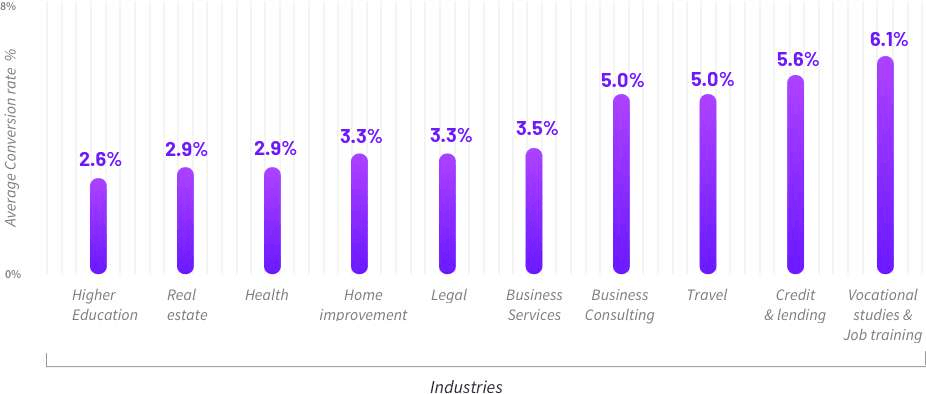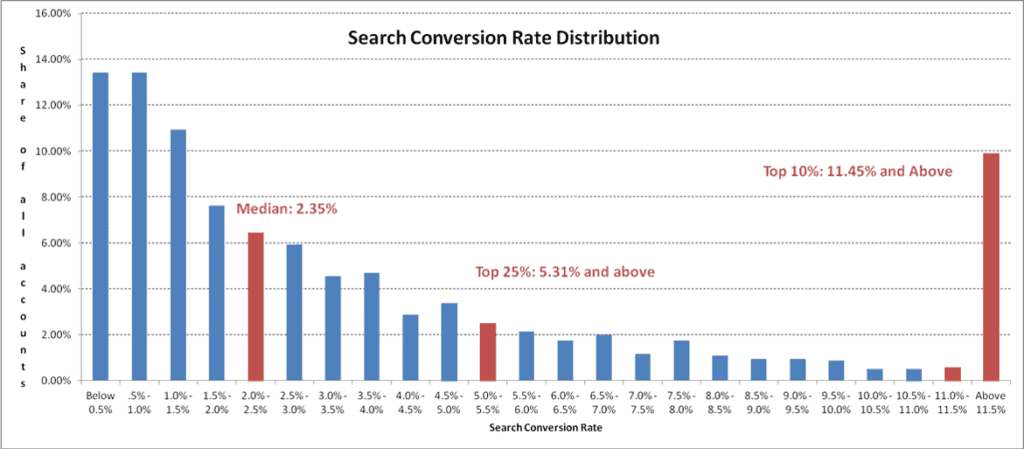Most digital marketers already recognize the importance of optimizing their PPC landing pages to achieve a good landing page conversion rate.
But, exactly what is a good landing page conversion rate?
This is one of the questions we hear most often from digital marketers who simply aren’t sure how to define success for their landing page optimization efforts. In practice, landing page optimization is an ongoing process of improvement with no real upper limit for success – so at what point should you look at your work and say “I’ve done a good job”?
That’s what we’re trying to help with by creating this resource. We’ll explain how landing page conversion rates work, how they vary between different industries, and what factors influence landing page conversion rate for a given campaign. By the end, we hope you’ll have a better idea of what is a good landing page conversion rate.
[optin-inline id=’d5yewatvtrhn8vieh0e4′]
What is a Landing Page Conversion Rate?
When you start a PPC advertising campaign, one of the first things you will do is determine a high-level strategic goal for your campaign. Broadly speaking, there are three strategic goals you can choose from:
- Generate brand awareness
- Generate qualified leads
- Generate sales
Once you have decided on a strategic goal, you need to create an offer. Your offer will be presented on your landing page to your target audience after they click on one of your paid advertisements or arrive from another targeted referral source. To succeed in PPC advertising, you need to know how to create a landing page. The purpose of a landing page is to encourage visitors to accept the offer, thereby fulfilling the goals of your campaign.
Offers can take many different forms that connect with your campaign goals.
Want to generate brand awareness? Use your landing page to connect visitors to your home page or another useful article or resource on your website.
Need to convert visitors into qualified leads? Your lead generation offer could be an email newsletter opt-in form, a website membership sign-up form or a webinar registration.
Ready to ask for the sale? You can offer a product or a service for sale directly on your landing page.
Landing page conversion rate is defined as the percentage of visitors to your landing page that takes the desired action by accepting your offer.
What is a Good Landing Page Conversion Rate?
Conventional wisdom dictates that a good landing page conversion rate is probably between 2-5%, with some high-performing landing pages achieving up to 10%+ conversion rates.
Well, we’d like to challenge that wisdom.
Consider the following two scenarios:
- Mike runs a SaaS business with a $500/month subscription product in a niche market. He builds a PPC campaign with the strategic goal of generating sales and pays an average CPC of $15.00. Mike’s calculated customer lifelong value (CLV) for his software product is around $10,000. Mike’s landing page converts at just 1.0%, which makes sense since his product is niche and quite expensive. Yet, even while converting only 1/100 visitors into customers, he can expect to earn $10,000 for every $1500 of ad spending. In regards to return on ad spend, that’s a successful campaign!
- Tony runs an online clothing store with fast fashion products. He builds a PPC campaign with the strategic goal of generating sales and pays an average CPC of $1.50. Tony has optimized his landing page to convert at 7.0%, with each converted sale generating $65 in profit. For every $150 of ad spending, Tony generates $455 in net profit for the business – not bad at all!
So, we have two profitable and successful campaigns, but with very different landing page conversion rates.
Not only that, but Mike’s campaign with the lower conversion rate actually has more than double the return-on-investment of Tony’s campaign.
Could you honestly say that Mike’s landing page conversion rate isn’t good, given what you know about his product and overall campaign profitability?
The lesson here is that while conversion rates are important, the real focus should be on overall return-on-investment and campaign profitability. Every business, product, service, PPC campaign and landing page has unlimited variables and unique characteristics that impact conversion rates in different ways.
Digital marketers need to optimize their overall PPC campaign to support downstream value creation, not focus on individual metrics like landing page conversion rates that are meaningless by themselves. Landing page conversion rate does not determine success in PPC advertising – campaign profitability does.
What is a Good Landing Page Conversion Rate for My Industry?
With that said, there is some information available about average conversion rates between industries that we wanted to share.

Image Source: Unbounce
The above graph was published by Unbounce, who conducted an analysis of landing page conversion rates across industries. There are two important details you should know about this data:
- This analysis was done using lead generation landing pages – not landing pages with a sales offer or brand awareness pages. Lead generation pages may ask for an email opt-in or webinar registration, so you’d expect higher conversions than with an eCommerce landing page that’s asking for a sale.
- These are median values – not averages. They don’t include the large numbers of low-converting landing pages or the small numbers of high-converting landing pages that exist.
Take a look at this chart published by WordStream and you’ll see what we mean:

Image Source: Wordstream
This conversion rate data is not for individual landing pages, but for individual advertiser accounts. That means the best advertisers are converting at more than 11.45% across their entire account, not just on individual landing pages. But here we have no sense of what kind of offers are being presented – are these brand awareness conversions, lead generations or sales?
Without that level of segmentation, it’s hard to make a solid connection between the bars on the chart and what landing page optimization rates you should expect for your own campaign.
The good news is that unless your landing pages are converting at 15% or more, you’re probably being outperformed by the best digital marketers and that means there’s plenty of room for improvement. In the final section of this resource, we’ll give you five quick pointers for landing page conversion rate optimization.
Five Tips to Achieve a Good Landing Page Conversion Rate
Refine Your Traffic Sources
One of the best ways to increase the overall conversion rate for your landing page is to refine your traffic referral sources and send more qualified users to your page. You don’t necessarily need a greater volume of leads, but you need to ensure as much as possible that visitors to your page are motivated to convert with your offer. To achieve this, you may want to adjust your ad creative, change your ad copy or change where your ads are being displayed.
Try Something New
If you’ve been sticking to simple text and images for your landing pages, there are several options you can explore that could lead to higher conversions. The best available data tells us that adding video to your landing pages can increase conversions. You could add a video testimonial, an explanation video about your product or a simple elevator pitch that encourages the conversion.
A/B Testing
A/B testing is a methodology for landing page optimization. When conducting A/B testing, you split the traffic from your PPC ads between two versions of the same landing page – an A version and a B version. The two versions should be identical with a single element changed, such as the headline, ad copy, offer, or call-to-action text. You can then use analytics to assess which version of the page generated more engagement and conversions. Once you’ve collected a big enough sample size, you decide which version is better and keep it.
You can keep A/B testing your landing page to push your conversion rates higher over time.
Split Testing
Digital marketers should be aware of the difference between A/B testing and split testing, and when to do each one.
In A/B testing, you’re showing target audience members one of two versions of the same landing page with a single design element changed or modified.
In a split test, you’re showing two different landing pages that can differ in just about every way, including the offer they present, ad copy, headlines and every other design element.
Split testing should be used to hone in on the most successful landing page design. A/B testing can then be used to optimize each element in that design to drive conversions.
Conversion Rate Optimization
Conversion rate optimization goes beyond referral sources and testing your landing pages. It also includes things like mobile optimization, page responsiveness, formatting, readability, page speed and many other factors that impact the overall user experience. We’ve created an entire conversion rate optimization course that covers all the info you’ll need to get the most out of your landing pages.
Summary
So, what is a good landing page conversion rate?
Honestly, it depends. While you can choose to benchmark your conversion rates against industry averages or the performance of the best advertisers, you shouldn’t focus too hard on achieving a specific target number.
Instead, you should take the appropriate steps to optimize your conversion rate as much as possible while driving down CPC and maximizing the value that you generate from each conversion. Effectively managing these factors means optimizing your overall PPC campaign for profitability and success.
-
 CEO
Garrett Mehrguth
CEO
Garrett Mehrguth
Did you enjoy this article?
Share it with someone!
